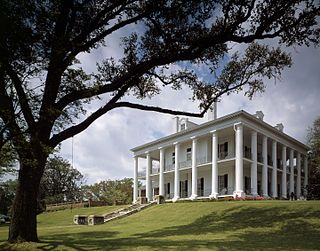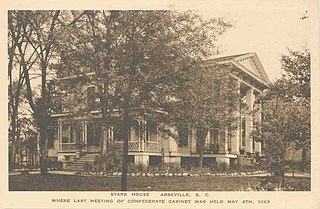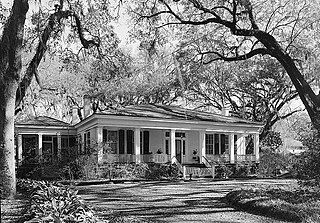
The White House of the Confederacy is a historic house located in the Court End neighborhood of Richmond, Virginia. Built in 1818, it was the main executive residence of the sole President of the Confederate States of America, Jefferson Davis, from August 1861 until April 1865. It was viewed as the Confederate States counterpart to the White House in Washington, D.C.
Highlands–Douglass is a neighborhood five miles (8 km) southeast of downtown Louisville, Kentucky, United States. The neighborhood is bound by Bardstown Road, Speed Avenue, Taylorsville Road, and Cherokee Park. It is considered a part of a larger area of Louisville called The Highlands. It is often simply called Douglass.
Benjamin Thornton Montgomery (1819–1877) was an influential African-American inventor, landowner, and freedman in Mississippi. He was taught to read and write, and became manager of supply and shipping for Joseph Emory Davis at Hurricane Plantation at Davis Bend.

Dunleith is an antebellum mansion at 84 Homochitto Street in Natchez, Mississippi. Built about 1855, it is Mississippi's only surviving example of a plantation house with a fully encircling colonnade of Greek Revival columns, a form once seen much more frequently than today. Now an inn and conference center, it was designated a National Historic Landmark in 1974. Currently the original horse stable serves as a fine dining establishment with a traditional English pub in the lower levels of the structure

Monmouth is a historic antebellum home located at 1358 John A. Quitman Boulevard in Natchez, Mississippi on a 26-acre (11 ha) lot. It was built in 1818 by John Hankinson, and renovated about 1853 by John A. Quitman, a former Governor of Mississippi and well-known figure in the Mexican–American War. It is one of Natchez's grandest Greek Revival mansions. It was declared a Mississippi Landmark in 1986 and a National Historic Landmark in 1988. It is now a small luxury hotel.

The Old Courthouse, Warren County, also known as Warren County Courthouse, stands prominently on a hill in Vicksburg, Mississippi, and was a symbol of Confederate resistance during the Siege of Vicksburg. It was designated a National Historic Landmark in 1968 and a Mississippi Landmark in 1986. The landmarked area comprises the entire Courthouse Square, which includes the courthouse and four attached buildings that were originally cistern houses for catching rainwater to fight fires, but these were later converted into offices.

Rosalie Mansion is a historic pre-Civil War mansion and historic house museum in Natchez, Mississippi. Built in 1823, it served as the architectural inspiration for a large number of Natchez's grand Greek Revival mansions, and was a major influence on Antebellum architecture in the greater region. During the American Civil War, it served as Union headquarters for the Natchez area from July 1863 on. It was designated a National Historic Landmark in 1989.

The Burt-Stark Mansion, also known as Armistead Burt House, in Abbeville, South Carolina was the site of the last Council of War of cabinet members of the Confederate government. On May 2, 1865, Jefferson Davis, hoping to continue the struggle, met unanimous opposition, and realized the Confederate independence cause was lost.

The historic village of Aurora, Cayuga County, New York, rises on a hill above the eastern shore of Cayuga Lake. The village was named by Captain Benjamin Ledyard, who settled there in 1793, in the post-Revolutionary development of the Finger Lakes region. Up until the mid-nineteenth century, Aurora played an important part in the history of Central New York.

Georgia Cottage, also known as the Augusta Evans Wilson House, is a historic residence in Mobile, Alabama, United States. It was added to the National Register of Historic Places on September 14, 1972, based on its association with Augusta Jane Evans. She was one of the most popular American novelists of the nineteenth century and the first female author in the United States to earn over $100,000 for her work, but has been largely forgotten in recent times.

Brierfield Plantation was a large forced-labor cotton farm built in 1847 in Davis Bend, Mississippi, south of Vicksburg and the home of Confederate president Jefferson Davis.

Hurricane Plantation located near Vicksburg, Mississippi, was the home of Joseph Emory Davis (1784–1870), the oldest brother of Jefferson Davis. Located on a peninsula of the Mississippi River in Warren County, Mississippi, called Davis Bend after its owner, Hurricane Plantation at its peak in the antebellum era comprised more than 5,000 acres (20 km2) with approximately 5 miles (8.0 km) of river frontage. Joseph Davis owned 346 enslaved people and had a personal worth of more than $600,000 in the 1860 U.S. Census, making him one of the wealthiest men in the state of Mississippi.

The F. H. Miller House is a historic building located in the central part of Davenport, Iowa, United States. The house served as the official residence for two of Davenport's Catholic bishops and as a bed and breakfast. The building now houses the Office of Advancement and Alumni Relations for St. Ambrose University, and is called Alumni House. It has been listed on the National Register of Historic Places since 1983.
Joseph Emory Davis was an American lawyer who became one of the wealthiest planters in Mississippi in the antebellum era; he owned thousands of acres of land and was among the nine men in Mississippi who owned more than 300 slaves. He was the elder brother of Jefferson Davis and acted as his surrogate father for several years. The younger Davis became a politician, U.S. Senator, and later President of the Confederacy.

St. Mary Historic District is a national historic district located at Lafayette, Tippecanoe County, Indiana. In 1864, St. Mary's Catholic Church relocated from its original site at Fifth and Brown Streets to Columbia Street. With the move, many of the congregation also moved to this area. The Church became both a religious and social center for the neighborhood. Many of the homes date from the 1860s and 1870s and include fine examples of the Italianate, Greek Revival and Queen Anne styles as well as vernacular house types. Most of the people who built in this area were Lafayette businessmen. At 1202 Columbia Street James Ball, a local wholesale grocer left his name stamped into the front steps. Across the street is the James H. Ward House, who along with his brother, William, owned a local carpet and wallpaper business.

The Woodland Plantation is a historic Southern plantation near Church Hill, Jefferson County, Mississippi. It retains its original antebellum 230 acre size, and has the tradition of primarily supplying hay to the area cattle. It also has a pecan orchard.

The Routhland is a historic mansion in Natchez, Mississippi. Construction began in 1815 in the Federal architectural style. It now has an Italianate style after extensive remodeling. The mansion has been listed on the National Register of Historic Places since August 22, 1977. It is located at 131 Winchester road in Natchez, Adams County, Mississippi.

Golladay Hall is a historic mansion in Grenada, Mississippi, USA. It was built in the 1850s on a Southern plantation for the Golladay family, members of the Southern aristocracy from Tennessee who owned plantations and invested in railroads. The mansion was used by Jefferson Davis, the President of the Confederate States of America, during the American Civil War. In 1932, a Golladay heiress was murdered inside the house. The mansion was restored in the 1950s.

The Neibert-Fisk House, also known as Choctaw, is a historic mansion in Natchez, Mississippi, USA.
















